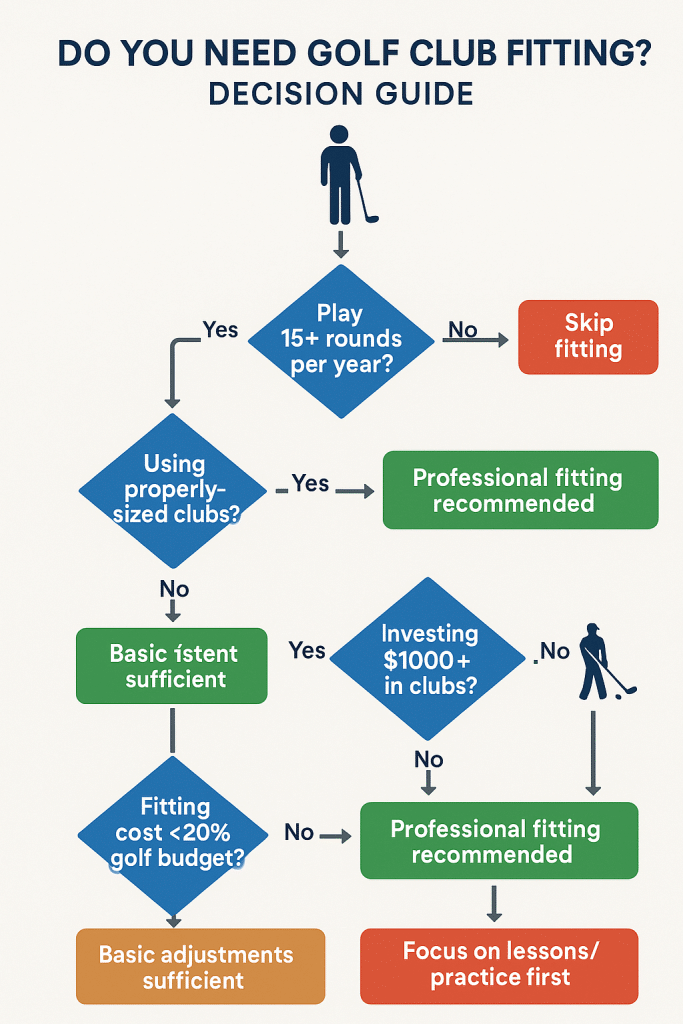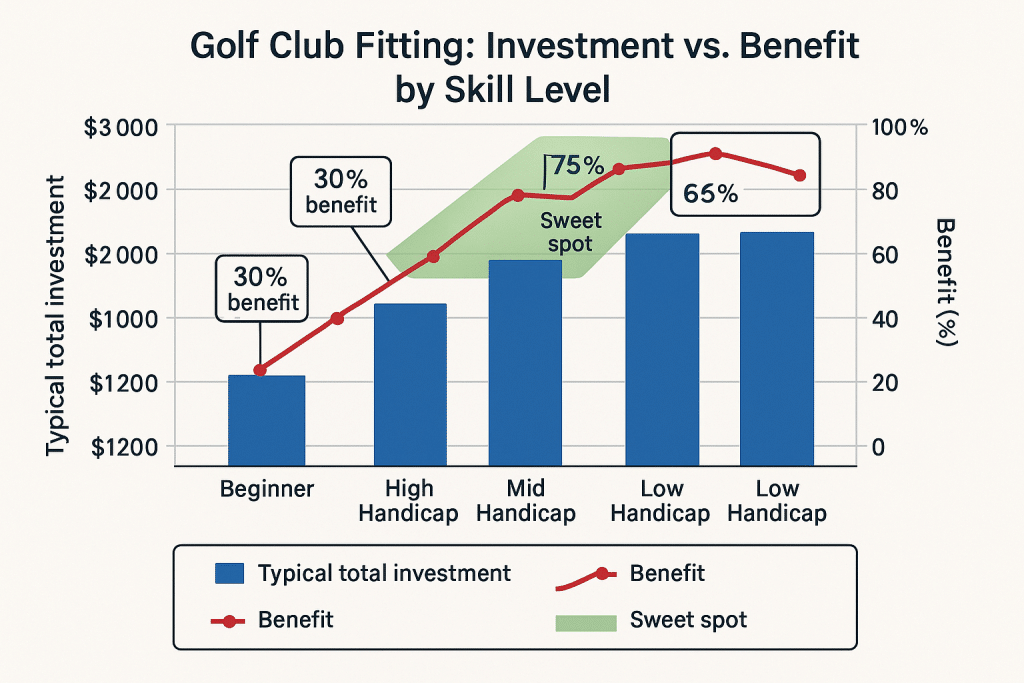The complete guide to making the right decision for your game and budget
Standing in a golf shop, overwhelmed by endless club options and conflicting advice about custom fitting? You're not alone. The golf industry has created a lot of confusion around when golfers actually need professional club fitting versus when standard clubs work just fine.
This comprehensive guide cuts through the marketing hype to give you clear, actionable advice on whether custom fitting is right for your game.
Whether you're a weekend warrior wondering if fitting is worth the investment, or an improving golfer unsure when to make the jump to custom clubs, this article will help you make an informed decision.
We'll explore the real benefits of fitting, identify clear signs you need it, and show you when you can save your money for other aspects of your game.
Before diving into fitting specifics, it's worth understanding how properly fitted equipment connects to your overall golf fundamentals and swing development.
The Truth About Golf Club Fitting in 2025
Golf club fitting has evolved dramatically over the past decade. What once was reserved for tour professionals is now accessible to golfers of all skill levels.
However, this accessibility has created confusion about who actually benefits from the process.
Research from leading golf instruction organizations shows some compelling statistics:
Golf Club Fitting Impact Statistics
| Skill Level | Handicap Improvement | Distance Gain | Accuracy Improvement | ROI Timeline |
|---|---|---|---|---|
| Beginners (25+ handicap) | 87% see 10%+ improvement | +8-15 yards average | +31% straighter shots | 3-6 months |
| Mid-Handicappers (10-20) | 73% improve 2+ strokes | +12-20 yards | +45% better contact | 2-4 months |
| Low Handicappers (Under 10) | 65% fine-tune performance | +5-8 yards optimization | +15% consistency | 1-2 months |
| Beginners (First year) | Variable results | Minimal impact | Can help or hinder | 12+ months |
Data compiled from TaylorMade Golf, True Spec Golf, and professional fitting studies
Industry data published by GOLF suggests that 87 percent of golfers who are custom fit lower their handicap by at least 10 percent. That means a 20 handicap can knock two strokes off just by having the proper equipment.
However, these statistics don't tell the whole story. The benefits of fitting depend heavily on your current skill level, equipment, and goals.
When You DEFINITELY Need Golf Club Fitting
1. You're Playing with Hand-Me-Down or Random Clubs
Research suggests that at least 75% of golfers are playing with the wrong clubs, wrong shafts, or both. If your clubs came from:
- A garage sale or used equipment grab bag
- A relative who's a different height or build
- A random starter set without consideration for your specifications
- Clubs that are decades old with outdated technology
You absolutely need fitting. Even basic measurements for length and lie angle can make dramatic improvements.
2. Clear Physical Mismatches
According to professional fitting guidelines, you need fitting if:
Height Issues:
- You're over 6'2" or under 5'6"
- You feel like you're reaching for the ball or hunching over significantly
- Standard clubs feel awkwardly long or short
Physical Proportions:
- Your wrist-to-floor measurement is significantly different from standard
- You have unusually long or short arms relative to your height
- Previous injuries affect your swing mechanics
3. Consistent Ball-Striking Problems
If you've recently lost or gained weight, increased your flexibility or changed your swing plane or tempo, it could be impacting the way your golf clubs work for your game.
Warning Signs Your Equipment is Wrong:
Equipment Mismatch Symptoms
BALL FLIGHT ISSUES:
├── Consistent slice with all clubs
├── Shots always go left (right-handed golfer)
├── Can't get ball airborne with irons
├── Driver shots balloon too high
└── Inconsistent distances between clubs
CONTACT PROBLEMS:
├── Hitting off toe consistently
├── Striking ball thin repeatedly
├── Heavy/fat contact despite good swing
├── Can't find center of clubface
└── Different contact patterns between clubs
FEEL ISSUES:
├── Clubs feel too heavy or too light
├── Can't sense where clubhead is during swing
├── Shafts feel too stiff or too flexible
├── Uncomfortable grip size
└── Balance feels off at address4. You've Improved Significantly
Even the best fitting doesn't last forever. Just because your specs worked five years ago or even last season, doesn't mean they still do.
Fitting Update Triggers:
- Your handicap has dropped 5+ strokes
- Swing speed has increased significantly
- You've taken extensive lessons and changed your swing
- Your course conditions have changed dramatically
5. You're Investing in New Equipment
If you're spending $1,000+ on new clubs, professional fitting should be non-negotiable.
50-100 dollars or pounds is a pretty standard rate for a custom fitting, and many places will knock that off the cost of the clubs if you do go on to place an order.
When You DON'T Need Golf Club Fitting
1. You're a True Beginner (Less than 6 Months Playing)
For beginners, it's likely the expert recommends more loft on your driver, lighter shafts with less flex, and more forgiving irons.
Skip fitting if:
- You've played fewer than 20 rounds total
- You're still learning basic fundamentals like proper stance and grip
- Your swing changes dramatically from lesson to lesson
- You haven't established consistent contact patterns
Better investments for new golfers:
- Quality instruction from a PGA professional
- Practice routine development
- Course management and golf etiquette
2. Your Current Clubs Are Already Well-Suited
You don't need new equipment for it to be right for your game. Daniel Berger uses cavity-back irons from 2011!
Signs your clubs are fine:
- Consistent ball contact and predictable ball flight
- Comfortable feel and proper length
- Distance gaps make sense between clubs
- No obvious physical mismatches
3. Budget Constraints Make It Impractical
Professional fitting costs range from $50-500, plus club costs can easily exceed $2,000. If that represents a significant financial burden:
Alternative approaches:
- Focus on used clubs with similar specifications to your current set
- Prioritize lessons and practice over equipment
- Consider just fitting for driver or irons (not full bag)
- Use online fitting calculators as a starting point
4. You Play Infrequently
If you're someone who just wants to get outside and swing the club, skip the fitting. Or, if you're someone who just goes out for fun, doesn't compete in any events, you can also skip the fitting.
Casual golfer criteria:
- Play fewer than 10 rounds per year
- No competitive aspirations
- Golf is purely recreational/social
- Current clubs don't cause obvious problems
The Middle Ground: Partial Fitting Options
Not everyone needs a full-bag fitting. Consider these targeted approaches:
Driver-Only Fitting
Best for:
- Golfers struggling with driving distance or accuracy
- Players comfortable with iron performance
- Budget-conscious golfers wanting maximum impact
Investment: $100-150 for fitting, $300-600 for driver
Iron Set Fitting
Best for:
- Players satisfied with driver performance
- Golfers with inconsistent iron contact
- Those prioritizing scoring clubs
Focus areas: Length, lie angle, shaft weight, and club composition
Basic Adjustments
Affordable options:
- Lie angle adjustments ($5-10 per club)
- Grip size changes ($8-15 per grip)
- Length modifications ($20-40 per club)
These basic modifications can provide 60-70% of the benefits of full custom fitting at a fraction of the cost.
Making the Fitting Decision: A Step-by-Step Guide

Step 1: Assess Your Current Equipment
Equipment Evaluation Checklist:
- Clubs are appropriate length for your height
- Lie angles produce straight shots with good contact
- Grip size feels comfortable
- Club composition matches your skill level
- Distance gaps between clubs are logical
Step 2: Evaluate Your Game Commitment
Questions to consider:
- How many rounds do you play annually?
- Are you taking regular lessons?
- Do you practice consistently?
- Are you competing or want to compete?
- Is golf a long-term hobby or passing interest?
Step 3: Identify Your Primary Challenges
Common fitting solutions:
Fitting Solutions by Problem
| Golf Challenge | Fitting Solution | Alternative Approach |
|---|---|---|
| Chronic slice | Draw-bias driver, adjusted lie angles | Swing fixes, grip changes |
| Lack of distance | Optimized loft/shaft combo | Swing speed training, technique |
| Inconsistent contact | Proper length/lie angles | Fundamental instruction |
| Poor ball flight | Shaft/loft optimization | Setup and stance improvements |
| Club gapping issues | Set composition changes | Course management, shot selection |
Step 4: Budget Reality Check
Fitting investment breakdown:
- Basic fitting: $50-150
- Premium fitting: $200-500
- Club costs: $800-3,000+
- Ongoing adjustments: $50-200
Alternative budget allocation:
- Lessons: $50-150 per session
- Practice facility membership: $50-200/month
- Used quality clubs: $300-1,200
What to Expect During a Professional Fitting
Understanding the fitting process helps you determine if it's worth your investment:
Pre-Fitting Preparation
What to bring:
- Current clubs you're considering replacing
- Golf shoes and glove
- Recent scorecards or swing data
- List of specific concerns or goals
Information to track beforehand:
- Typical miss patterns (slice, hook, fat, thin)
- Distance gaps between current clubs
- Specific clubs you struggle with
- Course conditions you typically play
The Fitting Process
Typical session includes:
- Assessment Phase (15-20 minutes)
- Discussion of goals and challenges
- Analysis of current equipment
- Basic measurements (height, arm length, hand size)
- Baseline Testing (15-20 minutes)
- Shots with current clubs
- Launch monitor data collection
- Identification of improvement opportunities
- Testing Phase (45-90 minutes)
- Systematic testing of different specifications
- Head-to-head comparisons
- Data analysis and recommendations
- Final Selection (15-20 minutes)
- Review of best-performing options
- Cost analysis and ordering process
- Timeline for delivery and follow-up
Key Metrics Measured
Modern fitting focuses on these critical data points:
Ball Flight Data:
- Carry distance and total distance
- Launch angle and ball speed
- Spin rate and landing angle
- Shot dispersion patterns
Club Performance:
- Impact location on clubface
- Attack angle and club path
- Face angle at impact
- Shaft loading characteristics
Fitting Costs: What's Worth the Investment?
Understanding fitting costs helps you budget appropriately:
Fitting Fee Structure
| Fitting Type | Typical Cost | Time Required | Best For |
|---|---|---|---|
| Basic/Express | $50-100 | 30-45 minutes | Single club, basic adjustments |
| Standard | $100-200 | 60-90 minutes | Driver or iron set |
| Premium | $200-500 | 2-4 hours | Full bag, advanced analysis |
| Tour-Level | $500+ | 4+ hours | Serious competitive players |

Hidden Costs to Consider
Additional expenses:
- Premium shaft upgrades: $100-400 per club
- Specialty grips: $15-50 per club
- Build and shipping: $50-200
- Future adjustments: $20-100
- Re-fitting as your game changes: $100-300
Return on Investment
Getting fit for the right clubs may be one of the easiest ways to take strokes off your game.
Calculate your ROI:
- Cost per round improvement
- Long-term equipment durability
- Enjoyment and confidence factors
- Potential to avoid future equipment purchases
Common Fitting Mistakes to Avoid
Mistake #1: Fitting Too Early in Your Golf Journey
Some golfers believe they have to get to a certain level to get fit, but that's a wrong perception. However, if you've never played and are still developing basic fundamentals, the benefits may be limited.
Better approach: Establish basic competency before major equipment investments
Mistake #2: Focusing Only on Distance
While distance improvements grab attention, accuracy and consistency often provide greater scoring benefits.
Balanced priorities:
- Accuracy and dispersion control
- Consistent contact and trajectory
- Proper gapping throughout the set
- Comfort and confidence at address
Mistake #3: Ignoring Your Typical Playing Conditions
If you go for a wedge fitting, in addition to the loft that you need, your fitter will talk to you about playing conditions. Is the sand fluffy and soft or is it hard-packed? Is the rough thick or are you mostly hitting from tighter lies?
Consider your environment:
- Course conditions (firm/soft, windy/calm)
- Altitude and climate factors
- Typical playing season length
- Indoor vs. outdoor practice availability
Mistake #4: Rushing the Decision
Quality fitting requires time for proper evaluation and comparison.
Best practices:
- Don't feel pressured to buy immediately
- Ask to take data and specifications home
- Research pricing from multiple sources
- Consider used options with your fitted specifications
Alternatives to Professional Fitting
If professional fitting isn't right for you currently, consider these alternatives:
Self-Assessment Tools
Online fitting calculators:
- Basic length and lie angle recommendations
- Shaft flex suggestions based on swing speed
- General club type recommendations
Limitations: Generic recommendations without personal data
Golf Shop Basic Fitting
Many retail locations offer basic fitting services:
Typical services:
- Length and lie angle adjustments
- Basic shaft flex recommendations
- Grip size modifications
Pros: Convenient and often free with purchase Cons: Limited options and expertise compared to premium fitters
Gradual Equipment Evolution
Systematic approach:
- Start with properly fitted driver
- Add iron adjustments over time
- Optimize wedges and putter
- Fine-tune as your game improves
Demo Programs
Many manufacturers offer demo programs:
Benefits:
- Try clubs on-course before purchasing
- Test multiple options without fitting fees
- Make informed decisions based on actual play
Special Considerations by Skill Level
High Handicappers (20+ handicap)
Sure, if you just walked off the course after your first-ever nine holes, it's probably worth spending some more time on the course and on the range before booking a fitting session.
But if you've played enough to establish a 20 handicap (or better), you are absolutely good enough to get fitted for golf clubs.
Fitting priorities:
- Forgiveness over precision
- Higher launching irons and driver
- Lighter shafts for easier swing
- Larger grips for better control
Consider: Game-improvement irons and forgiving drivers over player's clubs
Mid-Handicappers (10-20 handicap)
Prime fitting candidates:
- Consistent enough swing for meaningful data
- Skill level to benefit from optimization
- Improvement trajectory justifies investment
Fitting focus:
- Balanced performance and forgiveness
- Optimized launch conditions
- Proper gapping throughout set
- Shaft optimization for consistency
Low Handicappers (Under 10 handicap)
Precision fitting benefits:
- Small adjustments yield significant results
- Advanced shaft and head combinations
- Specialty wedge configurations
- Fine-tuned distance control
Considerations: May benefit from regular re-fitting as game evolves
The Future of Golf Club Fitting
Technology continues to evolve the fitting landscape:
Emerging Technologies
Advanced analytics:
- AI-powered swing analysis
- Biomechanical integration
- Environmental condition modeling
- Predictive performance algorithms
Accessibility improvements:
- Mobile fitting units
- Virtual reality simulation
- At-home fitting kits
- Online consultation integration
Cost Evolution
Fitting costs continue to decrease as technology becomes more accessible, making professional fitting available to more golfers.
Making Your Decision: A Practical Framework
Use this decision tree to determine your fitting needs:
Decision Framework
START: Do you play golf regularly (15+ rounds/year)?
├── NO → Focus on lessons and used equipment
└── YES → Continue
Are you using properly-sized equipment for your height?
├── NO → Basic fitting or adjustments needed
└── YES → Continue
Do you have consistent swing issues despite good instruction?
├── YES → Professional fitting likely beneficial
└── NO → Continue
Are you investing $1000+ in new equipment?
├── YES → Professional fitting recommended
└── NO → Consider basic adjustments or keep current clubs
Is fitting cost less than 20% of your annual golf budget?
├── YES → Fitting is reasonable investment
└── NO → Prioritize other game improvementsConclusion: Making the Right Choice for Your Game
Golf club fitting can be a valuable investment for the right golfer at the right time. The key is honest self-assessment of your skill level, commitment, and equipment needs.
Clear indicators you need fitting:
- Playing with obviously mis-matched equipment
- Consistent equipment-related ball striking issues
- Significant recent game improvement
- Major equipment purchase planned
When to skip fitting:
- Very early in your golf journey
- Infrequent or purely casual play
- Current equipment works well
- Budget constraints make it impractical
Remember: Great golf is built on fundamentals first, equipment second. Here's the thing, the right equipment can help your game tremendously. But no clubs can compensate for a bad swing that lacks fundamentals.
The best equipment in the world won't fix poor swing fundamentals, lack of course management, or inconsistent practice.
But when you have solid fundamentals and are committed to improvement, properly fitted equipment can absolutely help you reach your potential faster.
Consider your current skill level, improvement trajectory, and budget. If fitting makes sense for your situation, invest in quality instruction alongside your equipment to maximize the benefits.
If it doesn't, focus on developing your fundamentals and revisit the fitting question as your game progresses.
Whether you choose custom fitting or stick with off-the-rack clubs, the most important thing is getting out on the course and enjoying this incredible game.
Equipment can help, but ultimately, golf is about the journey of improvement and the friendships formed along the way.
Additional Resources:
- TaylorMade Fitting Guide
- True Spec Golf Fitting Information
- Club Champion Fitting Process
- Golf Digest Equipment Guidelines
About the Author: This article was researched and compiled using information from PGA professionals, certified club fitters, and leading golf equipment manufacturers.
The content is designed to help golfers make informed decisions about club fitting based on their individual needs and circumstances. For more golf improvement content, visit Golfers Paradise.
